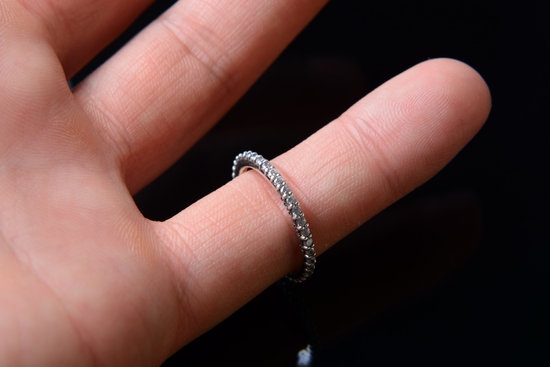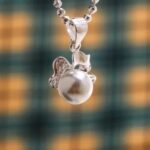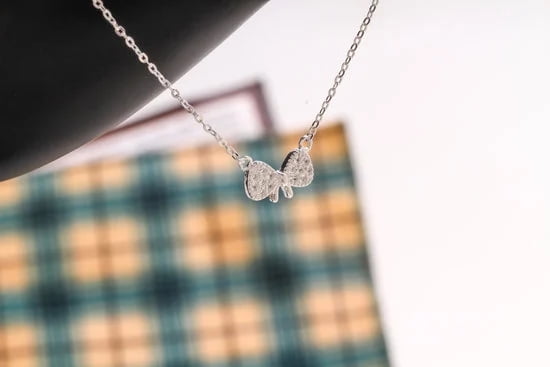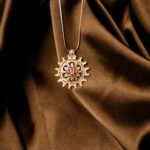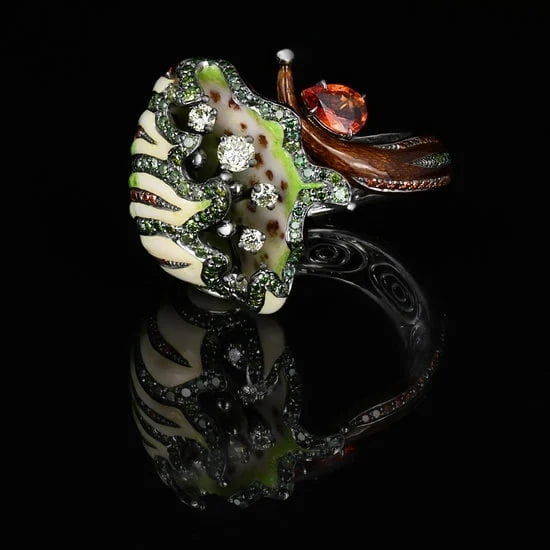When it comes to creating intricate and stunning pieces of jewelry, the process involves much more than simply setting a diamond into a prong or bezel. One crucial step in the jewelry-making process is drilling holes for diamond settings. This article will guide you through the process of drilling holes in jewelry, specifically for diamond settings, so you can create beautiful and secure pieces that truly stand out.
Drilling holes for diamond settings is essential because it allows for a secure and precise placement of the diamond within the piece. Whether you are creating a delicate necklace, an elegant ring, or a dazzling bracelet, drilling holes ensures that the diamonds are held securely in place while also enhancing their brilliance. Properly drilled holes enhance both the visual appeal and longevity of your jewelry creations.
To embark on this journey of incorporating diamond settings into your jewelry pieces, it’s important to understand the tools and equipment required for drilling holes. We will explore this in detail in section two, providing you with a comprehensive guide on everything you need to get started. From drill bits to lubricants, we will cover all the necessary elements to ensure successful drilling.
In section three, we will walk you through the step-by-step procedure of preparing your jewelry piece for drilling holes in diamond settings. This includes taking measurements, marking drill points, and securing your workpiece. By following these guidelines, you’ll be well on your way to mastering this technique and creating stunning pieces adorned with diamond settings.
Exploring the Tools and Equipment Required for Drilling Holes in Jewelry for Diamond Settings
When it comes to drilling holes for diamond settings in jewelry, having the right tools and equipment is crucial. Using the proper equipment will not only make the process easier but also ensure accurate and precise results. In this section, we will explore the various tools and equipment that are required for drilling holes in jewelry for diamond settings.
- Drill Press: A drill press is a stationary tool that provides stability and control while drilling holes. It allows for precise depth adjustments and reduces the risk of damaging the jewelry piece. When using a drill press, it is important to choose one with a high-quality chuck that can securely hold different types of drill bits.
- Drill Bits: Choosing the right drill bit is essential for successful drilling in jewelry. Diamond core drill bits are ideal for drilling through hard materials like metal or gemstones. They come in various sizes to accommodate different hole diameters. It is important to select a drill bit that matches the size of the diamond you are setting.
- Lubricant: Using a lubricant during the drilling process helps to keep the drill bit cool and prevent overheating. This not only extends the life of the drill bit but also improves its cutting performance. Petroleum-based lubricants or synthetic cutting fluids can be used for this purpose.
- Safety Equipment: Ensuring safety during drilling is paramount. Protective goggles should always be worn to protect your eyes from debris or splinters that may fly off during drilling. Additionally, gloves can be worn to provide added protection while handling sharp tools and materials.
By having these essential tools and equipment on hand, jewelers can confidently approach their drilling projects for diamond settings in jewelry. The right tools will make all the difference in achieving precise results and ensuring longevity in your creations.
Step-by-Step Procedure
The step-by-step procedure for preparing the jewelry piece for drilling holes in diamond settings is a crucial part of achieving precise and beautiful results. Before beginning the drilling process, it is important to properly prepare the jewelry piece to ensure that it remains sturdy and undamaged throughout the procedure.
- Clean the jewelry piece: It is essential to clean the piece before starting any type of drilling. Use a soft cloth or a jewelry cleaning solution to remove any dirt, oils, or residue from the surface of the jewelry. This will prevent any contaminants from interfering with the drilling process.
- Mark the drilling spot: Use a marker or a sharp pencil to mark the exact spot where you want to drill the hole for your diamond setting. Take measurements and ensure that the markings are accurate and aligned with your design plan. This step will help you achieve precision in your final result.
- Secure the jewelry piece: To prevent any movement or slipping during drilling, it is important to secure your jewelry piece in place. Use a clamp or a vise grip to hold it steady and ensure that it remains stable throughout the procedure. This will help maintain accuracy and prevent any accidents or damage caused by movement.
- Choose the appropriate drill bit: Selecting the right drill bit size is crucial for successful hole drilling in diamond settings. Consider factors such as stone size, material type, and design requirements when choosing your drill bit. A smaller size bit is recommended for more delicate pieces, while larger bits are suitable for larger stones or stronger materials.
| Procedure | Details |
|---|---|
| Clean the Jewelry Piece | Use a soft cloth or jewelry cleaning solution to remove dirt and residue from the surface. |
| Mark the Drilling Spot | Use a marker or sharp pencil to mark the exact spot where the hole will be drilled. |
| Secure the Jewelry Piece | Use a clamp or vise grip to hold the jewelry piece steady throughout the drilling process. |
| Choose the Appropriate Drill Bit | Select a drill bit size that is suitable for the stone size, material type, and design requirements. |
By following these steps, you can ensure that your jewelry piece is properly prepared for drilling holes in diamond settings. Taking the time to clean, mark, secure, and choose the appropriate drill bit will help you achieve accurate and beautiful results in your diamond setting project.
The Art of Choosing the Perfect Size and Type of Drill Bit for Diamond Settings in Jewelry
Choosing the right size and type of drill bit for diamond settings in jewelry is crucial for achieving precise and secure results. The drill bit you choose will largely depend on the size of the diamonds and the type of setting you plan to use. Here are some factors to consider when selecting a drill bit:
- Diamond Size: The size of the diamonds will determine the diameter of the hole you need to drill. It’s important to choose a drill bit that matches or slightly exceeds the diameter of your diamonds, ensuring a secure fit.
- Setting Type: Different types of diamond settings require different drill bit sizes and shapes. For example, a prong setting may require a round-shaped diamond bur, while a bezel setting may require a cylindrical-shaped bur. Consider the specific requirements of your chosen setting technique when selecting a drill bit.
- Material: The material you are drilling into will also impact your choice of drill bits. If you’re working with softer metals like gold or silver, standard high-speed steel (HSS) or carbide drill bits may be sufficient. However, if you’re drilling into harder materials like titanium or platinum, you may need to invest in diamond-coated or tungsten carbide bits for better results.
- Shank Size: The shank size of the drill bit must be compatible with your drilling equipment. Most rotary tools have adjustable collets to accommodate different shank sizes, but it’s important to ensure compatibility to avoid any issues during drilling.
By carefully considering these factors, you can select the ideal drill bit for your diamond settings in jewelry projects. It’s also advisable to practice on scrap pieces before working on valuable materials to familiarize yourself with different drill bits and their effects on various materials.
| Factors | Considerations |
|---|---|
| Diamond Size | Match or slightly exceed diameter |
| Setting Type | Select drill bit based on setting technique |
| Material | Choose appropriate drill bit material for hardness of material being drilled into |
| Shank Size | Ensure compatibility with drilling equipment |
Mastering the Technique
Drilling holes for diamond settings in jewelry requires a specific technique to ensure precision and accuracy. Here is a step-by-step guide on how to properly drill holes for diamond settings in jewelry:
- Choose the right drill bit: The first step is to select the appropriate drill bit for your project. Diamond core drills or twist drills with diamond coatings are recommended for drilling into hard materials like metal. Make sure to choose a drill bit size that matches the diameter of the diamonds you will be setting.
- Mark the spot: Use a marker or punch to mark the exact location where you want to drill the hole on your jewelry piece. This step is crucial as it ensures that your diamonds will be properly aligned and evenly spaced.
- Secure the piece: Place your jewelry piece securely in a vise or clamp to prevent any movement while drilling. This will help maintain stability and reduce the risk of damage during the drilling process.
- Apply lubricant: Before you start drilling, it is important to apply lubricant, such as cutting oil or beeswax, to reduce friction and heat generated during the drilling process. Apply a small amount of lubricant directly onto the marked spot.
- Start drilling slowly: Begin drilling at a slow speed while applying gentle pressure on the jewelry piece. This will prevent overheating and minimize any potential damage to your piece.
- Maintain control: As you continue drilling, make sure to keep a steady hand and maintain control over both speed and pressure applied. It is advisable to periodically pause and check your progress, ensuring that you are not damaging any surrounding areas.
- Clean and inspect: Once you have successfully drilled through, remove the jewelry piece from the vise or clamp and clean off any debris that may have accumulated during drilling. Inspect the hole carefully to ensure it is clean, smooth, and free from any jagged edges.
By following these steps, you can master the technique of drilling holes for diamond settings in jewelry, ensuring precise and professional results. Remember to always practice caution and take your time during the drilling process to avoid any mishaps or damage to your precious jewelry pieces.
Diamond Setting Options for Drilled Holes
Diamond Setting Options for Drilled Holes: Prong, Bezel, or Channel? Exploring Different Setting Techniques
When it comes to setting diamonds in drilled holes, there are various techniques that jewelers can employ to achieve different aesthetic effects. The choice of setting technique depends on the desired look and style of the jewelry piece, as well as factors such as the size and shape of the diamonds being used. In this section, we will explore three popular diamond setting options for drilled holes: prong setting, bezel setting, and channel setting.
Prong Setting
Prong setting is perhaps the most widely recognized and traditional method for securing diamonds in jewelry. In this technique, small metal claws called prongs are used to hold the diamond securely in place. Prong settings allow maximum light penetration, which enhances the brilliance of the diamond. This type of setting also exposes a larger portion of the diamond’s surface area, allowing it to catch more light from different angles.
Bezel Setting
A bezel setting involves creating a metal rim around the perimeter of the diamond to hold it in place. This type of setting offers excellent protection for the diamond as it surrounds the entire stone with metal. Bezel settings can be either full or partial, depending on how much of the diamond’s edge is covered. Full bezels provide maximum security while partial bezels expose more of the stone for increased light reflection.
Channel Setting
Channel setting is commonly used when creating designs with multiple diamonds. In this technique, a narrow groove or channel is carved into the metal to accommodate several diamonds side by side. The stones are then set into this groove using small strips or bars of metal that hold them securely in place. Channel settings create a smooth and continuous look, with no visible prongs or bezels interrupting the flow of diamonds.
Each setting option has its own unique advantages and considerations. Jewelers should take into account factors such as the overall design of the jewelry piece, the size and shape of the diamonds, and the level of security and protection required for the stones when choosing a setting technique for drilled holes. By carefully considering these factors, jewelers can achieve beautiful and functional diamond settings that enhance the overall visual appeal of the jewelry.
Tips and Tricks for Successful Drilling
Proper Alignment and Marking
One of the key challenges when drilling holes for diamond settings is ensuring precise alignment and marking on the jewelry piece. This is essential to create a clean and accurate hole that will securely hold the diamond.
To overcome this challenge, it is recommended to use a center punch or an awl to make a small indentation at the exact spot where the hole needs to be drilled. This will act as a guide for the drill bit and help maintain accuracy throughout the drilling process.
Lubrication for Smooth Drilling
Drilling through metal can generate a significant amount of heat, which can damage both the drill bit and the jewelry piece. To prevent this, it is crucial to use lubrication during the drilling process. Applying a small amount of lubricant such as beeswax or cutting oil to the surface of the drill bit will help reduce friction, dissipate heat, and ensure smooth drilling. It is important to apply lubrication periodically throughout the drilling process for optimal results.
Gradual Drilling Technique
Drilling holes in diamond settings requires patience and precision. A common mistake is rushing through the process, which can result in a damaged jewelry piece or an ill-fitting setting for the diamond. To ensure success, it is advisable to adopt a gradual drilling technique.
Start with a smaller drill bit size than required and slowly increase the size with each subsequent drilling until reaching the desired diameter for the setting. This gradual approach allows for better control and minimizes risks of errors or accidents.
Cooling Methods
As mentioned earlier, heat generation during drilling can be detrimental to both your tools and jewelry piece. In addition to using lubrication, employing cooling methods can further enhance your drilling success rate. One effective way is using water or coolant while drilling holes for diamond settings.
You can either fully immerse the jewelry piece in a container filled with water or direct a stream of coolant onto the drilling area. This method helps to dissipate heat, prolong the lifespan of your drill bits, and prevent any potential damage to the diamonds or other gemstones.
Backup Support
To minimize the risk of damaging the jewelry piece during drilling, it is advisable to use a backup support system. This can be achieved by placing a small block of wood or plastic underneath the area where you will be drilling. The backup support provides stability and prevents any unwanted movement when applying pressure during drilling. Additionally, it helps protect delicate stones or intricate designs from potential damage caused by excessive force.
By implementing these tips and tricks, jewelers can overcome common challenges encountered when drilling holes for diamond settings in jewelry. Maintaining accuracy, using lubrication, adopting gradual drilling techniques, employing cooling methods, and utilizing backup support all contribute to ensuring precise and successful diamond settings that enhance the overall brilliance and longevity of the jewelry piece.
Safety First
When it comes to drilling holes for diamond settings in jewelry, safety should always be a top priority. Working with power tools and delicate materials like diamonds can be risky if proper precautions are not taken. In this section, we will discuss important safety measures and practices that should be followed to ensure a safe and successful drilling process.
One of the first things to consider is wearing appropriate safety gear. Protective eyewear should always be worn to prevent any eye injuries that may occur from flying debris or metal shards. Additionally, gloves can help protect your hands from sharp edges or accidents while handling the jewelry piece or using the drilling equipment.
Another crucial aspect of safety is securing the jewelry piece properly. It is important to make sure that the jewelry is securely held in place during the drilling process. This can be achieved by using clamps or a vice to secure the piece firmly. Ensuring stability will prevent slipping or accidental movements that could lead to damage or injury.
Additionally, it is essential to work in a well-ventilated area or use proper respiratory protection when drilling holes in jewelry for diamond settings. The dust particles generated during drilling can be harmful if inhaled, especially if toxic materials such as metals or gemstone fragments are being drilled into. Using a dust mask or respirator will help minimize health risks.
Furthermore, maintaining a clean workspace is crucial for both safety and efficiency. Having clutter-free surroundings will reduce the chances of accidents occurring due to tripping over objects or knocking over equipment. Regularly cleaning up metal shavings and debris also helps maintain precision and accuracy during the drilling process.
By following these important precautionary measures and best practices, jewelers can ensure a safe working environment while drilling holes for diamond settings in their jewelry pieces. Safety should never be compromised when working with valuable materials like diamonds, ensuring not only personal well-being but also preserving the quality of the finished product.
Aftercare and Maintenance
After drilling the holes for diamond settings in your jewelry, it is crucial to prioritize proper aftercare and maintenance to ensure the longevity and brilliance of your pieces. This section will provide you with essential tips on how to protect and preserve the drilled holes, allowing your diamonds to shine for years to come.
To begin, it is important to handle your jewelry with care. Avoid touching the diamonds directly with your fingers as natural oils and dirt can adhere to the surface, dulling their sparkle. Use a soft cloth or gloves when handling the pieces and keep them stored in a separate compartment or pouch away from other jewelry to prevent scratching.
Regular cleaning is also necessary to maintain the brilliance of your drilled diamond settings. However, extra caution must be exercised during this process. Avoid using harsh chemicals or abrasive cleaners that can damage both the diamonds and the surrounding metal. Instead, opt for gentle jewelry cleaners specifically designed for delicate gemstones like diamonds. You can also clean your pieces with warm soapy water using a soft toothbrush to remove any dirt or debris.
Furthermore, it is recommended to have your jewelry professionally inspected and cleaned at least once a year by a trusted jeweler. They have specialized equipment that can thoroughly clean hard-to-reach areas around the drilled holes without causing any damage. Moreover, they can check the structural integrity of the diamond settings which may loosen over time due to everyday wear.
Lastly, storing your drilled diamond-set jewelry properly ensures its safety and longevity. Invest in a jewelry box with individual compartments or use jewelry pouches lined with soft fabric where each piece can be stored separately. This prevents tangling, scratching, and unnecessary rubbing against other items.
Taking these aftercare and maintenance measures will help you enjoy your dazzling diamond-set jewelry for years to come while ensuring that those carefully drilled holes continue showcasing their brilliance.
Frequently Asked Questions
How do you drill holes in gemstones for jewelry?
When drilling holes in gemstones for jewelry, it is important to use the right tools and techniques to avoid damaging the stone. Firstly, select a drill bit appropriate for the hardness of the gemstone; diamond bits are typically used for harder materials, while other abrasive bits work well for softer gems. Begin by securing the gemstone securely in a holding device to prevent it from moving during drilling.
Apply gentle pressure and lubricate the drill bit with water or oil, depending on the type of stone, to reduce heat and prevent chipping or cracking. Proceed slowly and steadily to allow the bit to cut through the gemstone gradually. Patience is crucial during this process to ensure clean and precise holes without causing any harm to the gemstone.
How do you drill a hole in a diamond?
Drilling a hole in a diamond requires specialized tools and techniques due to its exceptional hardness. Diamond drill bits or core drills that are coated with industrial diamonds are essential for drilling into diamonds effectively. The drilling process should be done using constant water flow or oil coolant to prevent overheating and maintain lubrication between the diamond surface and drill bit.
Additionally, professionals often use ultrasonic assisted drilling equipment that helps in decreasing friction and vibration during the process, reducing potential damage risk. Precision control and slow speed are vital when drilling diamonds to avoid any loss of material or fractures on this incredibly valuable gem.
What are the holes in a diamond setting?
The holes in a diamond setting refer to openings within the metal structure where diamonds or other gemstones are placed securely onto jewelry. These holes serve multiple purposes: they enable light to pass through the stones, enhancing their brilliance and sparkle, while also allowing easy cleaning of both sides of the stones.
The size of these holes depends on various factors like the shape, size, and design requirements of each particular jewelry piece. Often seen as prongs or channels in traditional settings like solitaire rings or pave bands respectively, these carefully positioned holes ensure proper positioning of the diamonds while optimizing their aesthetic appeal and overall security within the jewelry setting.

Welcome to my jewelry blog! My name is Sarah and I am the owner of this blog.
I love making jewelry and sharing my creations with others.
So whether you’re someone who loves wearing jewelry yourself or simply enjoys learning about it, be sure to check out my blog for insightful posts on everything related to this exciting topic!

